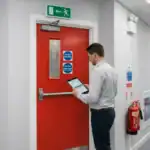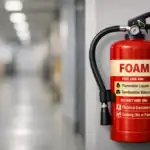
Good safety managers see accidents and near misses the same way: Whether someone is actually injured doesn’t matter – any adverse event is a sign something is wrong in your workplace. But workers who escape injury might not share the same opinion, which can create obstacles for near miss reporting systems.
This guide explains how to improve near miss reporting. It covers tackling the common challenges managers face when developing reporting systems and the benefits of getting them right.
What is Near Miss Reporting?
A near miss is a dress rehearsal for an accident. Both events involve the same players, choices and unsafe conditions, but in a near miss, no one’s injured.
Because near misses and accidents are only separated by outcomes, near misses can be used to interrogate and improve safety systems before something more serious happens.
Near miss reporting (NMR) is the process of gathering and acting on the information a near miss can reveal. Handled correctly, NMR offers multiple benefits, including:
- Improved safety: Addressing near misses can prevent actual accidents and injuries.
- Reduced costs: Preventing accidents saves compensation costs and downtime.
- Enhanced compliance: Regular near miss reporting helps your organisation stay compliant with health and safety laws.
- Better risk management: Analysing near miss data can identify accident trends and systemic issues.
- Increased productivity: Safe employees are more engaged and productive.
Challenges to Effective Near Miss Reporting
Despite its benefits, near miss reporting can be challenging to implement effectively.
The first issue is gathering accurate reports. Employees may underestimate the value of reporting and assume that incidents without injury aren’t worth the time and effort. Or it may be an issue of psychological safety. Workers who fear blame for reporting near misses will remain silent.
Then there’s the follow-up. Near miss reporting is only worthwhile if it leads to discernible safety improvements. You must be able to analyse near miss data and identify what needs fixing. Workers (and higher-ups) must also see how you’ve made the workplace safer as a result. Otherwise, they’ll lose faith in your NMR systems.
Near Miss Training
Our Near Miss Training course helps line managers extract valuable lessons from near misses to drive safety improvements. Users learn to work effectively with front-line staff to reveal problems and analyse the underlying contexts that cause human errors.
How to Improve Near Miss Reporting
Improving near miss reporting involves addressing the common challenges:
- Limited reporting
- Poor psychological safety
- Lack of clear follow-up
This section explains how you can overcome these obstacles.
Gathering Accurate Reports from Workers
The first step in improving your NMR system is ensuring workers understand why they should make near miss reports.
Educate your team on the value of near miss reporting and how it can prevent future accidents. Also, specify what should be reported. Workers may assume you only want accident reports, so make it clear all near misses are a concern and worthy of investigation.
If reports are still rare, review the reporting process. Is it straightforward? Busy workers won’t appreciate overly complicated procedures and may choose to skip reporting anything less than a serious incident. So, streamline the process as much as possible.
Using Safety Tripwires
You can set your preferred reporting threshold by using safety tripwires. Safety tripwires are cues that something’s wrong and set a clear condition for reporting.
To create a safety tripwire, identify safety-critical situations. Determine the key areas or scenarios where hazards could occur in your workplace. These might include specific equipment, processes or higher-risk locations.
Establish observable cues that indicate a potential hazard. These cues should be straightforward and easily identifiable. Develop clear instructions for workers to follow when they encounter these cues. For example, “If you notice a loose guardrail (cue), then report it immediately to the supervisor (action).”
Promoting Psychological Safety
Psychological safety is often the biggest obstacle to effective near miss reporting. Even with the simplest NMR system, workers won’t make reports if they don’t feel comfortable. You need to make it clear you use reports to make people safer, not find someone to blame.
Lay the foundation for open communication by regularly asking your team for feedback and showing genuine interest in their concerns and safety observations.
When employees report near misses, thank them for their honesty and courage. Praise and reward those who contribute to the reporting process. This positive response will remind them (and their colleagues) that reports are valued and help make a safer workplace.
You should also lead by example. Managers must demonstrate transparency and take a non-punitive approach to near miss reporting. Regularly discuss the importance of reporting near misses in team meetings and share examples of how these reports have led to positive changes. Your colleagues will gradually recognise reporting as a constructive action that benefits everyone.

Managing Data and Following Up
After reports start coming in, you need the tools to analyse and resolve them.
First, develop a streamlined process for managing near miss reports. Use a centralised system to collect and store data, making it easier to track and analyse. A physical book (such as the one sold by the Health and Safety Executive) is one option. Regularly review the reports to identify patterns and recurring issues that need addressing.
Next, analyse the data to pinpoint areas for improvement. Look for trends that indicate systemic issues, such as repeated near misses in a particular location or involving specific equipment.
Once trends and issues are identified, take action to address them. This could involve updating safety protocols, providing additional training or making physical changes to the workplace. Ensure that these changes are communicated to all employees so they understand how their reports are contributing to a safer work environment.
How to Improve Near Miss Reporting – Key Takeaways
- Make it easy for employees to report near misses to increase participation and help gather accurate reports.
- Build psychological safety to ensure employees report near misses honestly and consistently.
- Streamline processes for handling and analysing near miss data to identify actionable safety improvements.
- Demonstrate how near miss reports resulted in real changes to encourage further reporting.
Maximising Learning from Near Miss Reports
Near miss reporting is essential for modern safety management. Our online Near Miss Training course can help you master it.
This comprehensive course is designed to help line managers and supervisors develop the skills needed to capture and analyse near miss reports effectively.
It covers critical areas such as promoting psychological safety, understanding human factors and using systems thinking to draw meaningful lessons from near misses. By completing this training, you’ll be equipped to make significant, lasting improvements to your workplace safety systems.





















